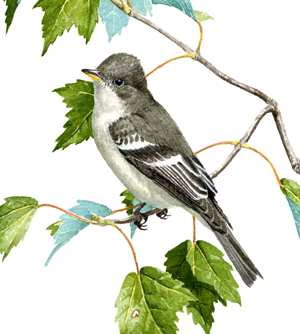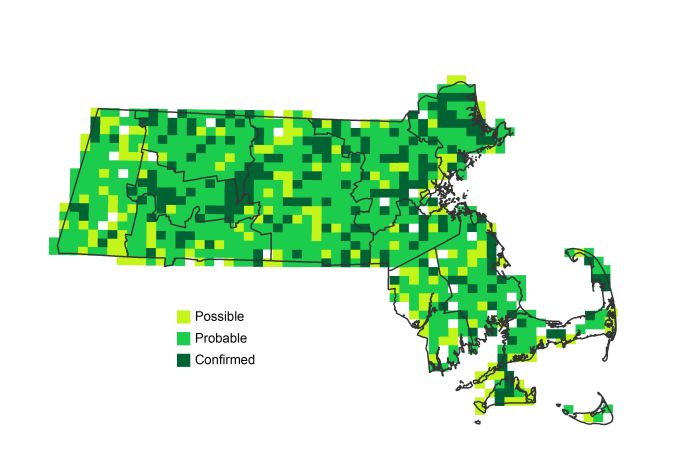Find a Bird
Eastern Wood-Pewee
Contopus virens

Nearly ubiquitous and likely increasing
Action/monitoring needed
“’Dear bird,’ I said, ‘what is thy name?’ / And thrice the mournful answer came, / So faint and far, and yet so near, - / ‘Pe-wee! pe-wee! peer!’” – John Townsend Trowbridge, “The Pewee”
Eastern Wood-Pewees are among the more familiar breeding flycatcher species in Massachusetts. They are found throughout the Commonwealth in all but the most closed forests. Due to their preference for foraging in the forest canopy, they are not often seen, and even when seen their appearance is subtle, not flashy. Regardless, their presence in the breeding season is easily ascertained by listening for their plaintive pee-a-wee song, which reverberates through summer woodlands from early June through the end of August.
Historic Status
“Steady as she goes" might be the catchphrase for the Eastern Wood-Pewee, the range of which has not changed considerably since the 1890s. Valued for both its song and its insectivorous habits, the pewee was not intentionally persecuted by mankind. However, the widespread changes wrought upon the forests of the Commonwealth have likely caused shifts in pewee distribution. Arthur Cleveland Bent wrote in the early 1940s that the bird was decreasing in eastern Massachusetts (Bent 1942), and Breeding Bird Survey studies started in the 1960s mirror this same trend elsewhere in the Northeast.
Atlas 1 Distribution
Contrary to what its name might suggest, the Eastern Wood-Pewee was most concentrated in the western part of the state in Atlas 1. The Vermont Piedmont region, with 77% block occupancy, had the lowest proportion of breeding pewees west of the Connecticut River Valley. Most western ecoregions had only 1 or 2 unoccupied blocks, and the Marble Valleys region had 100% block occupancy. The Connecticut River Valley region, as well as the Worcester and Lower Worcester Plateau regions, hovered just below 75% block occupancy. Eastern Wood-Pewees were somewhat scarcer in the Coastal Plains, though they were present in more than half of all blocks. The species also had a similar distribution in the Bristol/Narragansett Lowlands and the Cape and Islands. Only the deforested Boston Basin earned the dubious distinction of having less than 50% pewee block occupancy.
Atlas 2 Distribution and Change
By the time of Atlas 2 pewees were more widespread in eastern Massachusetts. While not truly ubiquitous, there were few places in the state where Eastern Wood-Pewees could not be found breeding. Though the western regions posted small declines, the losses were localized. Every region from the Connecticut River Valley eastward reported at least a modest increase in the presence of breeding pewees. In some cases, the increase was more than modest. The Coastal Plains, Boston Basin, and Bristol/Narragansett Lowlands regions experienced particularly remarkable upticks in Eastern Wood-Pewee breeding activity, with each region reporting net gains of 20% or more. Some shuffling of wood-pewee presence occurred on the Cape and Islands, but total occupancy remained essentially unchanged.
Atlas 1 Map

Atlas 2 Map

Atlas Change Map

Ecoregion Data
Atlas 1 | Atlas 2 | Change | ||||||
Ecoregion | # Blocks | % Blocks | % of Range | # Blocks | % Blocks | % of Range | Change in # Blocks | Change in % Blocks |
Taconic Mountains | 15 | 93.8 | 2.2 | 25 | 100.0 | 2.8 | 0 | 0.0 |
Marble Valleys/Housatonic Valley | 39 | 100.0 | 5.8 | 37 | 94.9 | 4.1 | -2 | -5.1 |
Berkshire Highlands | 54 | 98.2 | 8.0 | 51 | 92.7 | 5.6 | -4 | -7.5 |
Lower Berkshire Hills | 27 | 96.4 | 4.0 | 29 | 93.5 | 3.2 | -1 | -3.7 |
Vermont Piedmont | 13 | 76.5 | 1.9 | 17 | 100.0 | 1.9 | 1 | 8.3 |
Berkshire Transition | 33 | 86.8 | 4.9 | 40 | 100.0 | 4.4 | 2 | 6.5 |
Connecticut River Valley | 41 | 73.2 | 6.1 | 61 | 93.8 | 6.7 | 10 | 20.8 |
Worcester Plateau | 58 | 74.4 | 8.6 | 84 | 95.5 | 9.3 | 3 | 6.3 |
Lower Worcester Plateau | 55 | 74.3 | 8.1 | 79 | 98.8 | 8.7 | 7 | 13.0 |
S. New England Coastal Plains and Hills | 172 | 63.7 | 25.4 | 267 | 94.3 | 29.5 | 60 | 26.5 |
Boston Basin | 25 | 44.6 | 3.7 | 38 | 67.9 | 4.2 | 13 | 23.6 |
Bristol and Narragansett Lowlands | 67 | 63.2 | 9.9 | 89 | 78.1 | 9.8 | 22 | 21.8 |
Cape Cod and Islands | 77 | 56.6 | 11.4 | 88 | 61.1 | 9.7 | 2 | 1.7 |
Statewide Total | 676 | 69.8 | 100.0 | 905 | 87.3 | 100.0 | 113 | 13.6 |
Notes
Although the Atlas trends show the Eastern Wood-Pewee’s distribution to be increasing in Massachusetts, the Breeding Bird Survey (BBS) shows significant declines in abundance for Massachusetts, the New England/Mid-Atlantic Region, and the Eastern US overall. They fall into our “whispering bird” category – those species with a demonstrated stable or increasing breeding footprint from Atlas 2 data, but also a demonstrated decline in abundance from the BBS. This drives our final assessment that this is a species with a need for further monitoring.



